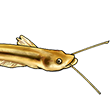When populations of known Hypancistrus are added to the map (e.g. Lower Negro, Rio Demini), I fail to see the disjunction between these distributions. Subject to sampling biases, it appears to me these fishes have effectively dispersed, colonised and speciated in most available habitats (deep, rocky, clear/blackwater rivers) of the Amazon/Orinoco system.
Even taking into account some sampling bias (which I do not think there is a lot of given the commercial collection of these fish) the described spp, with the possible exception of
H. inspector, all have very limited natural ranges and have not effectively dispersed. You can for example collect
Panaque maccus in any one of 100s of Orinoco tributaries, but the Orinoco
Hypancistrus only occupy a very small, restricted area. If they existed outside those areas commercial collectors would have found those populations. I understand that it is the same in the Xingu. I wish I could do a map like Mats did, but consider this:
Orinoco complex
H. contradens Rio Ventuari, 94 km E San Fernando de Atabapo
H. debilittera 38 kilometers north of San Fernando de Atabapo
H. furunculus 60 kilometers east of San Juan de Atabapo
H. lunaorum Río Guapuchi, first major riffle complex, Río Ventuari drainage
Negro
Hypancistrus inspector Rio Negro (Barcelos)
Xingo
H. zebra Xingu, near Altamira
The Xingu population of
Hypancistrus is separated from the others by 1500 miles as the crow flies and effectively 3000 plus miles by the way rivers flow. The two populations are also separated by a massive natural barrier (the main Amazon river channel). I would call this a disjunction.
I agree that sometimes the genus given to an L-number is incorrect - "blue panaque" turns out to be Baryancistrus beggini rather than a Panaque species. But most of the time, I'd say it's not that far off the mark.
Ah, like when it was L 46
Hypostomus "zebra" in the first L Number books, or when it was L 46
Peckoltia sp?

I am looking at Glasser's (1998) book right now and see: LDA 25 Hypostomus (actually Parotocinclus), L 124 Ancistrus, also listed in another L Number book as Hypostomus (actually Peckoltia), L 168 Lasiancistrus (Dekeyseria), L 2 Peckoltia (Panaque), I could go on and on. Look back at some of the L Number books from the mid to late 90s and you'll see what I am saying, they were off at least as often than not and I suspect they still are.
All this is supposition though, really.
That may be one of the few facts in this thread.
-Shane
"My journey is at an end and the tale is told. The reader who has followed so faithfully and so far, they have the right to ask, what do I bring back? It can be summed up in three words. Concentrate upon Uganda."
Winston Churchill, My African Journey













